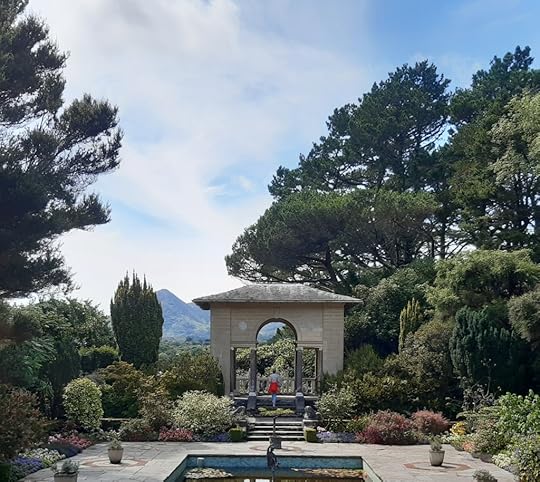The Funny History of Gazebo
Hello,
This week it’s another word suggested by the Teen Book Club members at Academy Books and it’s one with a long and convoluted history – gazebo. Clarity when it comes to gazebos is tough to come by so I’ll take this one step by step.
Step One – how do you say gazebo?
I say gah-zee-bow (bow like bow and arrow) but apparently it’s guh-ZEE-bow. There’s an audio file here, if you’re confused. There’s a slight difference on US vs UK English pronunciation, just to add a little spice to proceedings.
Step Two – what is a gazebo exactly?
The Cambridge dictionary says it’s (1) a small decorated building with roof and open sides usually in a garden, (2) a tent with open sides used for outdoor events, (3) a small shelter without walls in an open space where people can rest and relax.
 Italian style gazebo at the wonderful gardens on Garnish Island, Co. Cork
Italian style gazebo at the wonderful gardens on Garnish Island, Co. CorkStep Three – what’s the history of the gazebo?
Gazebos have been around much longer than their name. Similar structures pop up throughout ancient history. I’m going to summarise here but if you’d like a longer discussion check out this link.
As early as 2,600 BC the Egyptians had gazebos in their gardens, often placed beside fish ponds, and possibly to serve as temples. These are shown in tomb paintings from that period. The Greeks used their public gazebos to shelter from the sun while discussing politics and the issues of the day and they sometimes contained statues of the gods. The Romans reserved theirs for the gardens of the wealthy.
The Persians, famous for their hanging gardens to Babylon, brought gazebos to the next level. Despite gardening in the desert of what is now Iran, their engineers brought melted snow water from the mountains to provide irrigation. Their two-storey gazebos included marble floors cooled by underground water.
The French brought the gazebo to Europe and in Tudor times your garden gazebo would mimic the style of your grand house in England. Parallel to all these were the oriental versions of such structures. China began with garden temples and pagodas around the 4th century and this spread to Japan where sometimes the structures were used for their tea ceremony.
Step Four – Where does the word come from?
The word entered English in the mid 1700s and was popularised thanks to the book “New Design for Chinese Temples” by William Halfpenny (still available on Amazon if you’re curious). There are two theories on the source of the word itself. The first, and least accepted, is that it comes from the French phrase “que c’est beau” (how beautiful). If you say this with a French accent and speak quickly it can be misheard as gazebo. Many words form in this fashion, Santa Claus is an example.
The more likely story is that gazebo is a Latin joke. Such language jokes were surprisingly common during that time period and a few of them have appeared on this blog in previous posts. With Latin widely taught at English fee-paying schools it was popular to create words using it. The idea on this one is that it was compounded from the English word gaze (to view) with the Latin suffix ebo (I shall).
Until next time, happy reading, writing, and wordfooling,
Grace (@Wordfoolery)
p.s. Garnish Island, whose gazebo is pictured above, is well worth a visit, by the way. It’s on the Wild Atlantic Way in Cork and you take a short boat-ride out to view the island which is entirely covered in amazing gardens. You can read more about it here.



